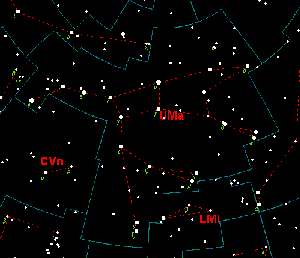
![[de]](../../Logos/flag_ger.gif)
![[it]](../../Logos/flag_it.gif)
Particulars:
General:
Constellation of the northern hemisphere; in central europe this constellation
never touches the horizon.
Ursa Major is a good starting point to find other stars and constellation in
the sky (see "how to find
constellations"):
Following the line leading from alpha UMa to beta UMa, one can
find easily the pole star (Polaris, alphastar of the Little Bear).
The constellation Charioteer (Auriga) can be found when following the line
leading from delta UMa to alpha UMa. Its leading directly to
alpha Aur (Capella).
Drawing a line from delta UMa to beta UMa and beyond, you will
find alpha Gem (Castor in the constellation
Twins).
This constellation is most famous for the
asterism Big Dipper,
build by the stars alpha UMa, beta UMa, gamma UMa, delta UMa, epsilon UMa,
zeta UMa and eta UMa.
Additional image available:
Stars and objects
The multiple star system zeta UMa (called Mizar - from
the arabian word for girdle) belongs to the most famous multiple stars in the
sky. It's brightness is about 2.4 mag; therefore under very good conditions it
is possible for the naked eye to see the 4th mag. companion, called 'Alcor' or
80 UMa (otherwise a small binocular will help). In small telescops
another 4th mag star becomes visible. Each of these stars is as well a
spectroscopic binary.
Xi UMa is a binary with an orbiting period of 60 years. At the point
when they seemed to be farthest away from each other they can be viewed with
smaller scopes (as it was the case 1975), but at their closest (in 1992) one
needs at least an aperture of 15 cm to resolve the components.
Even with smaller scopes M81 is worth for observing. On photographs it reveals
one of the most beautiful spirals in the sky. Please check the Messier Database
for more info about M81 and
M82.
Mythological Background:
According to greek mythology one day the Godfather Zeus saw a beautiful girl,
the nymph Kallisto, and fell in love with her. But Kallisto was one of the
virgin followers of the virgin goddess Diana, the huntress. So Zeus took
the form of Diana to approach Kallisto and managed it to make love to her.
Once Diana saw what had happened (Kallisto was obviously pregnant, when Diana
and all her nymphs take a bath), she send Kallisto away. Even worse, Hera, the
wife of Zeus heard about Kallisto and her now born son Arkas and become
terribly jealous. In her anger she turned her into a bear.
Years later Kallisto, still a bear, met her son Arkas, but was of course not
recognized by him. In his fear Arkas tried to kill the bear, but Zeus himself
took both of them an placed them between the stars and made them two
neighbouring constellations.
When Hera saw Kallisto glittering with the stars she furiously went down to
the ocean to meet Thethys and Oceanos. She told them the story and ask a
favour: that the bear never ever is able to reach the water. And indeed, as
said above, in the northern hemisphere, the constellation of the Great Bear
never touches the ocean.
(This story can be found in "Metamorphoses, book II" by the roman poet Ovid
(Publius Ovidius Naso, 43 BC to 17 AC). Its's an intersting that he speaks of
the seven stars of the Bear. This implies that in those times just the stars
forming the asterism of the Big Dipper were meant to form the bear. Though
these stars are even nowadays called the Great Bear, the constellation is a
bit more extended.)
![[Constellations]](../../Logos/constS_s.gif)
![[Home]](../../Logos/maa_s.gif)